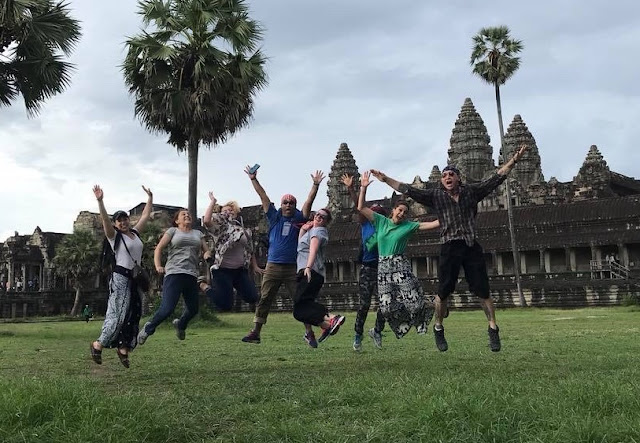Today we started work at the village school, a 45-minute bus ride from our hotel. Even though it was Sunday and the children were not required to be there, they showed up to welcome us. They formed two rows for us to pass between while they clapped and sang, boys on one side and girls on the other, arranged youngest to oldest.
 |
| School children lined up to greet the volunteers |
Ordinarily the children wear school uniforms, but today they wore all manner of clothes--Hello Kitty t-shirts, sports jerseys, pajama pants patterned with Paul Frank's monkeys, and dresses with plastic pearl necklaces. They watched us shyly from the distance as we were issued straw hats and gloves and got to work.
 |
| Children observe while the volunteers dig. |
The school consists of a dirt courtyard surrounded by a small library and four classrooms, two of which are open to the air. The classrooms have no electricity, and water comes from a hand-pump near the entrance.
We are building a fifth open-air classroom. The work goes very slowly. Our first task was to dig five holes for the building's concrete pillars. There were far more volunteers than needed to accomplish this task, but we had only three hoes, and most of us were inexperienced at using the long, narrow blade. The exception was Mani, who grew up in Burundi. "I have been doing this since I was eight years old," she laughed.
Several skilled workers hired by Global Heritage Tours watched our inexpert efforts. Clearly they could build this classroom much more quickly without us. We are here less for our labor, than for our own education, and to a certain extent for our wealth. The money each of us paid for this trip provides the materials and workers needed for the project. And our work isn't without value. Eventually the skilled workers took over to finish the holes and set the concrete pillars in them, and we assisted by mixing concrete, hauling sand and rocks, and pumping water. This was work all of us could do.
 |
| Michelle wears a garland made by the girls. |
Gradually the children became bolder and began to gather close to the work site. I greeted them with
soursdey, and they giggled and replied with
hello. I held out my hand in the universal gesture of "give me five," and the boldest girl, around eight years old, slapped my palm hard. Soon outstretched hands encircled me, waiting to give me five. This devolved quickly into a flurry of hand-slapping and laughter.
The girls in particular were eager to make friends with the women volunteers. They wove us strands of flowers and presented us with bouquets of leaves. The children speak very little English, and we know even less Khmer, but we found ways to communicate. One girl offered me a piece of bubble gum and we competed to see who could blow the biggest bubble. She popped mine whenever she could.
 |
| Our bubble contest |
Like children everywhere, the girls wanted me to take their picture and then show them the image on my phone. Both boys and girls gathered around while I shared pictures and videos of my children and pets. They wanted to see the video of my pet hedgehog over and over.
 |
| My new friend poses for a picture. |
Even more fascinating to them were James's videos of his children skiing. James lives in Calgary, where skiing is a part of life for anyone with enough money to buy a lift ticket. But for Cambodian children who have never seen snow, skiing must seem like a very exotic form of entertainment.
As the day dragged on in the oppressive heat, most of the children headed home for lunch. The skilled workers, too, left for several hours. We ate the meal provided by Global Heritage and tried to cool off in the shade. Curious dogs and a few chickens kept us company until the workers and some of the children returned.
 |
| These small dogs are everywhere--skittish but sooooooo cute! |
The day's work finished up mid-afternoon. We celebrated the end of the first day with coconut water, sipped through a straw in the coconut itself. Back at the hotel, I felt enormously grateful for the air conditioning and running water--luxuries that the school children don't have.




















































